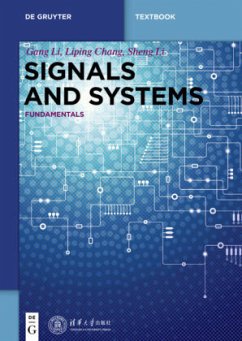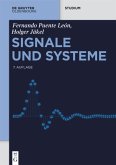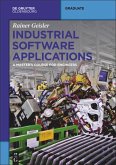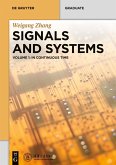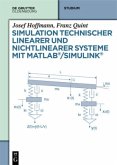- Broschiertes Buch
- Merkliste
- Auf die Merkliste
- Bewerten Bewerten
- Teilen
- Produkt teilen
- Produkterinnerung
- Produkterinnerung
Signals and systems enjoy wide application in industry and daily life, and understanding basic concepts of the subject area is of importance to undergraduates majoring in engineering. With rigorous mathematical deduction, this introductory text book is helpful for students who study communications engineering, electrical and electronic engineering, and control engineering. Additionally, supplementary materials are provided for self-learners.
Andere Kunden interessierten sich auch für
![Signale und Systeme Signale und Systeme]() Fernando Puente LeónSignale und Systeme74,95 €
Fernando Puente LeónSignale und Systeme74,95 €![Industrial Software Applications Industrial Software Applications]() Rainer GeislerIndustrial Software Applications39,99 €
Rainer GeislerIndustrial Software Applications39,99 €![Dealing with Electronics Dealing with Electronics]() Manfred DrosgDealing with Electronics53,99 €
Manfred DrosgDealing with Electronics53,99 €![In Continuous Time In Continuous Time]() In Continuous Time64,95 €
In Continuous Time64,95 €![In Discrete Time In Discrete Time]() In Discrete Time64,95 €
In Discrete Time64,95 €![The Fundamentals of Electrical Engineering The Fundamentals of Electrical Engineering]() Felix HüningThe Fundamentals of Electrical Engineering30,99 €
Felix HüningThe Fundamentals of Electrical Engineering30,99 €![Simulation technischer linearer und nichtlinearer Systeme mit MATLAB/Simulink Simulation technischer linearer und nichtlinearer Systeme mit MATLAB/Simulink]() Josef HoffmannSimulation technischer linearer und nichtlinearer Systeme mit MATLAB/Simulink39,95 €
Josef HoffmannSimulation technischer linearer und nichtlinearer Systeme mit MATLAB/Simulink39,95 €-
-
-
Signals and systems enjoy wide application in industry and daily life, and understanding basic concepts of the subject area is of importance to undergraduates majoring in engineering. With rigorous mathematical deduction, this introductory text book is helpful for students who study communications engineering, electrical and electronic engineering, and control engineering. Additionally, supplementary materials are provided for self-learners.
Hinweis: Dieser Artikel kann nur an eine deutsche Lieferadresse ausgeliefert werden.
Hinweis: Dieser Artikel kann nur an eine deutsche Lieferadresse ausgeliefert werden.
Produktdetails
- Produktdetails
- De Gruyter Textbook
- Verlag: De Gruyter
- 1. Auflage
- Seitenzahl: 284
- Erscheinungstermin: 25. September 2015
- Englisch
- Abmessung: 240mm x 170mm x 16mm
- Gewicht: 484g
- ISBN-13: 9783110378115
- ISBN-10: 3110378116
- Artikelnr.: 41051324
- Herstellerkennzeichnung Die Herstellerinformationen sind derzeit nicht verfügbar.
- De Gruyter Textbook
- Verlag: De Gruyter
- 1. Auflage
- Seitenzahl: 284
- Erscheinungstermin: 25. September 2015
- Englisch
- Abmessung: 240mm x 170mm x 16mm
- Gewicht: 484g
- ISBN-13: 9783110378115
- ISBN-10: 3110378116
- Artikelnr.: 41051324
- Herstellerkennzeichnung Die Herstellerinformationen sind derzeit nicht verfügbar.
Gang Li, Liping Chang, Sheng Li, Zhejiang University of Science and Technology, Hangzhou, China.
Preface
1 Introduction 1
1.1 Overview of signals and systems
1.1.1 What is a signal?
1.1.2 What is a system? .
1.2 Description and classiation of signals
1.2.1 Continuous-time signals and discrete-time signals
1.2.2 Energy signals and power signals
1.2.3 Periodic signals and non-periodic signals
1.2.4 Deterministic signals and random signals
1.2.5 Elementary signals
1.3 Systems description
1.3.1 Elementary systems
1.3.2 System modelling
1.4 Properties of systems
1.4.1 Memoryless and with memory
1.4.2 Causality
1.4.3 Invertibility
1.4.4 Stability
1.4.5 Time-invariance
1.4.6 Linearity
1.5 Summary
1.6 Problems
2 Time-domain Analysis of LTI Systems
2.1 Introduction
2.2 The unit impulse response and convolutions
2.2.1 The convolution sum
2.2.2 The convolution integral
2.3 Properties of convolutions and equivalent systems
2.4 Causality and stability of LTI systems
2.5 Systems constrained with linear dierential and dierence equations .
2.5.1 Continuous-time systems constrained with LCCDEs
2.5.2 Discrete-time systems characterized by LCCDEs
2.6 Summary
2.7 Problems
3 Fourier Analysis of Signals
3.1 Introduction
3.2 Fourier series for continuous-time periodic signals
3.3 Fourier series for discrete-time periodic signals
3.4 Why should a signal be transformed?
3.5 Fourier transform for continuous-time signals
3.5.1 Properties of Fourier transform
3.5.2 Inverse Fourier transform
3.6 The discrete-time Fourier transform
3.6.1 Properties of DTFT
3.6.2 Inverse DTFT
3.7 Fourier series and Fourier transforms
3.8 Summary
3.9 Problems
4 Frequency-domain Approach to LTI Systems
4.1 Introduction
4.2 Frequency response of LTI systems
4.3 Properties of frequency responses and bode plots
4.4 Frequency response of LTI systems characterized by LCCDEs
4.5 Frequency domain approach to system outputs
4.6 Some typical LTI systems
4.6.1 All-pass systems
4.6.2 Linear phase response systems
4.6.3 Ideal transmission channels
4.6.4 Ideal lters
4.7 Summary
4.8 Problems
5 Discrete Processing of Analog Signals
5.1 Introduction
5.2 Sampling of a continuous-time signal
5.3 Spectral relationship and sampling theorem
5.4 Reconstruction of continuous-time signals
5.5 Hybrid systems for discrete processing of analog signals
5.6 Discrete Fourier transform (DFT)
5.7 Compressed sensing
5.8 Summary
5.9 Problems
6 Transform-domain Approaches 194
6.1 Motivation
6.2 The Laplace transform
6.2.1 Derivation of the transform
6.2.2 Region of convergence (ROC)
6.2.3 Inverse Laplace transform (ILT)
6.2.4 Properties of Laplace transform
6.3 The z-transform
6.3.1 Region of convergence
6.3.2 Properties of the z-transform
6.3.3 Inverse z-transform
6.4 Transform-domain approach to LTI systems
6.4.1 Transfer function of LTI systems
6.4.2 Revisit of LTI systems stability and causality
6.4.3 Transfer function of LTI systems by LCCDEs
6.5 Transform domain approach to the solutions of LCCDEs
6.6 Unilateral transforms .
6.6.1 Unilateral Laplace transform
6.6.2 Unilateral z-transform
6.7 Summary
6.8 Problems
7 Structures and State-space Realizations
7.1 Block-diagram representation
7.2 Structures of LTI systems with a rational transfer function
7.3 State-space variable representation
7.3.1 State model and state-space realizations
7.3.2 Construction of an equivalent state-space realization
7.3.3 Similarity transformations
7.4 Discretizing a continuous-time state model
7.5 Summary
7.6 Problems
8 Comprehensive Problems
8.1 Motivation
8.2 Problems
Appendices
Bibliography
Index
1 Introduction 1
1.1 Overview of signals and systems
1.1.1 What is a signal?
1.1.2 What is a system? .
1.2 Description and classiation of signals
1.2.1 Continuous-time signals and discrete-time signals
1.2.2 Energy signals and power signals
1.2.3 Periodic signals and non-periodic signals
1.2.4 Deterministic signals and random signals
1.2.5 Elementary signals
1.3 Systems description
1.3.1 Elementary systems
1.3.2 System modelling
1.4 Properties of systems
1.4.1 Memoryless and with memory
1.4.2 Causality
1.4.3 Invertibility
1.4.4 Stability
1.4.5 Time-invariance
1.4.6 Linearity
1.5 Summary
1.6 Problems
2 Time-domain Analysis of LTI Systems
2.1 Introduction
2.2 The unit impulse response and convolutions
2.2.1 The convolution sum
2.2.2 The convolution integral
2.3 Properties of convolutions and equivalent systems
2.4 Causality and stability of LTI systems
2.5 Systems constrained with linear dierential and dierence equations .
2.5.1 Continuous-time systems constrained with LCCDEs
2.5.2 Discrete-time systems characterized by LCCDEs
2.6 Summary
2.7 Problems
3 Fourier Analysis of Signals
3.1 Introduction
3.2 Fourier series for continuous-time periodic signals
3.3 Fourier series for discrete-time periodic signals
3.4 Why should a signal be transformed?
3.5 Fourier transform for continuous-time signals
3.5.1 Properties of Fourier transform
3.5.2 Inverse Fourier transform
3.6 The discrete-time Fourier transform
3.6.1 Properties of DTFT
3.6.2 Inverse DTFT
3.7 Fourier series and Fourier transforms
3.8 Summary
3.9 Problems
4 Frequency-domain Approach to LTI Systems
4.1 Introduction
4.2 Frequency response of LTI systems
4.3 Properties of frequency responses and bode plots
4.4 Frequency response of LTI systems characterized by LCCDEs
4.5 Frequency domain approach to system outputs
4.6 Some typical LTI systems
4.6.1 All-pass systems
4.6.2 Linear phase response systems
4.6.3 Ideal transmission channels
4.6.4 Ideal lters
4.7 Summary
4.8 Problems
5 Discrete Processing of Analog Signals
5.1 Introduction
5.2 Sampling of a continuous-time signal
5.3 Spectral relationship and sampling theorem
5.4 Reconstruction of continuous-time signals
5.5 Hybrid systems for discrete processing of analog signals
5.6 Discrete Fourier transform (DFT)
5.7 Compressed sensing
5.8 Summary
5.9 Problems
6 Transform-domain Approaches 194
6.1 Motivation
6.2 The Laplace transform
6.2.1 Derivation of the transform
6.2.2 Region of convergence (ROC)
6.2.3 Inverse Laplace transform (ILT)
6.2.4 Properties of Laplace transform
6.3 The z-transform
6.3.1 Region of convergence
6.3.2 Properties of the z-transform
6.3.3 Inverse z-transform
6.4 Transform-domain approach to LTI systems
6.4.1 Transfer function of LTI systems
6.4.2 Revisit of LTI systems stability and causality
6.4.3 Transfer function of LTI systems by LCCDEs
6.5 Transform domain approach to the solutions of LCCDEs
6.6 Unilateral transforms .
6.6.1 Unilateral Laplace transform
6.6.2 Unilateral z-transform
6.7 Summary
6.8 Problems
7 Structures and State-space Realizations
7.1 Block-diagram representation
7.2 Structures of LTI systems with a rational transfer function
7.3 State-space variable representation
7.3.1 State model and state-space realizations
7.3.2 Construction of an equivalent state-space realization
7.3.3 Similarity transformations
7.4 Discretizing a continuous-time state model
7.5 Summary
7.6 Problems
8 Comprehensive Problems
8.1 Motivation
8.2 Problems
Appendices
Bibliography
Index
Preface
1 Introduction 1
1.1 Overview of signals and systems
1.1.1 What is a signal?
1.1.2 What is a system? .
1.2 Description and classiation of signals
1.2.1 Continuous-time signals and discrete-time signals
1.2.2 Energy signals and power signals
1.2.3 Periodic signals and non-periodic signals
1.2.4 Deterministic signals and random signals
1.2.5 Elementary signals
1.3 Systems description
1.3.1 Elementary systems
1.3.2 System modelling
1.4 Properties of systems
1.4.1 Memoryless and with memory
1.4.2 Causality
1.4.3 Invertibility
1.4.4 Stability
1.4.5 Time-invariance
1.4.6 Linearity
1.5 Summary
1.6 Problems
2 Time-domain Analysis of LTI Systems
2.1 Introduction
2.2 The unit impulse response and convolutions
2.2.1 The convolution sum
2.2.2 The convolution integral
2.3 Properties of convolutions and equivalent systems
2.4 Causality and stability of LTI systems
2.5 Systems constrained with linear dierential and dierence equations .
2.5.1 Continuous-time systems constrained with LCCDEs
2.5.2 Discrete-time systems characterized by LCCDEs
2.6 Summary
2.7 Problems
3 Fourier Analysis of Signals
3.1 Introduction
3.2 Fourier series for continuous-time periodic signals
3.3 Fourier series for discrete-time periodic signals
3.4 Why should a signal be transformed?
3.5 Fourier transform for continuous-time signals
3.5.1 Properties of Fourier transform
3.5.2 Inverse Fourier transform
3.6 The discrete-time Fourier transform
3.6.1 Properties of DTFT
3.6.2 Inverse DTFT
3.7 Fourier series and Fourier transforms
3.8 Summary
3.9 Problems
4 Frequency-domain Approach to LTI Systems
4.1 Introduction
4.2 Frequency response of LTI systems
4.3 Properties of frequency responses and bode plots
4.4 Frequency response of LTI systems characterized by LCCDEs
4.5 Frequency domain approach to system outputs
4.6 Some typical LTI systems
4.6.1 All-pass systems
4.6.2 Linear phase response systems
4.6.3 Ideal transmission channels
4.6.4 Ideal lters
4.7 Summary
4.8 Problems
5 Discrete Processing of Analog Signals
5.1 Introduction
5.2 Sampling of a continuous-time signal
5.3 Spectral relationship and sampling theorem
5.4 Reconstruction of continuous-time signals
5.5 Hybrid systems for discrete processing of analog signals
5.6 Discrete Fourier transform (DFT)
5.7 Compressed sensing
5.8 Summary
5.9 Problems
6 Transform-domain Approaches 194
6.1 Motivation
6.2 The Laplace transform
6.2.1 Derivation of the transform
6.2.2 Region of convergence (ROC)
6.2.3 Inverse Laplace transform (ILT)
6.2.4 Properties of Laplace transform
6.3 The z-transform
6.3.1 Region of convergence
6.3.2 Properties of the z-transform
6.3.3 Inverse z-transform
6.4 Transform-domain approach to LTI systems
6.4.1 Transfer function of LTI systems
6.4.2 Revisit of LTI systems stability and causality
6.4.3 Transfer function of LTI systems by LCCDEs
6.5 Transform domain approach to the solutions of LCCDEs
6.6 Unilateral transforms .
6.6.1 Unilateral Laplace transform
6.6.2 Unilateral z-transform
6.7 Summary
6.8 Problems
7 Structures and State-space Realizations
7.1 Block-diagram representation
7.2 Structures of LTI systems with a rational transfer function
7.3 State-space variable representation
7.3.1 State model and state-space realizations
7.3.2 Construction of an equivalent state-space realization
7.3.3 Similarity transformations
7.4 Discretizing a continuous-time state model
7.5 Summary
7.6 Problems
8 Comprehensive Problems
8.1 Motivation
8.2 Problems
Appendices
Bibliography
Index
1 Introduction 1
1.1 Overview of signals and systems
1.1.1 What is a signal?
1.1.2 What is a system? .
1.2 Description and classiation of signals
1.2.1 Continuous-time signals and discrete-time signals
1.2.2 Energy signals and power signals
1.2.3 Periodic signals and non-periodic signals
1.2.4 Deterministic signals and random signals
1.2.5 Elementary signals
1.3 Systems description
1.3.1 Elementary systems
1.3.2 System modelling
1.4 Properties of systems
1.4.1 Memoryless and with memory
1.4.2 Causality
1.4.3 Invertibility
1.4.4 Stability
1.4.5 Time-invariance
1.4.6 Linearity
1.5 Summary
1.6 Problems
2 Time-domain Analysis of LTI Systems
2.1 Introduction
2.2 The unit impulse response and convolutions
2.2.1 The convolution sum
2.2.2 The convolution integral
2.3 Properties of convolutions and equivalent systems
2.4 Causality and stability of LTI systems
2.5 Systems constrained with linear dierential and dierence equations .
2.5.1 Continuous-time systems constrained with LCCDEs
2.5.2 Discrete-time systems characterized by LCCDEs
2.6 Summary
2.7 Problems
3 Fourier Analysis of Signals
3.1 Introduction
3.2 Fourier series for continuous-time periodic signals
3.3 Fourier series for discrete-time periodic signals
3.4 Why should a signal be transformed?
3.5 Fourier transform for continuous-time signals
3.5.1 Properties of Fourier transform
3.5.2 Inverse Fourier transform
3.6 The discrete-time Fourier transform
3.6.1 Properties of DTFT
3.6.2 Inverse DTFT
3.7 Fourier series and Fourier transforms
3.8 Summary
3.9 Problems
4 Frequency-domain Approach to LTI Systems
4.1 Introduction
4.2 Frequency response of LTI systems
4.3 Properties of frequency responses and bode plots
4.4 Frequency response of LTI systems characterized by LCCDEs
4.5 Frequency domain approach to system outputs
4.6 Some typical LTI systems
4.6.1 All-pass systems
4.6.2 Linear phase response systems
4.6.3 Ideal transmission channels
4.6.4 Ideal lters
4.7 Summary
4.8 Problems
5 Discrete Processing of Analog Signals
5.1 Introduction
5.2 Sampling of a continuous-time signal
5.3 Spectral relationship and sampling theorem
5.4 Reconstruction of continuous-time signals
5.5 Hybrid systems for discrete processing of analog signals
5.6 Discrete Fourier transform (DFT)
5.7 Compressed sensing
5.8 Summary
5.9 Problems
6 Transform-domain Approaches 194
6.1 Motivation
6.2 The Laplace transform
6.2.1 Derivation of the transform
6.2.2 Region of convergence (ROC)
6.2.3 Inverse Laplace transform (ILT)
6.2.4 Properties of Laplace transform
6.3 The z-transform
6.3.1 Region of convergence
6.3.2 Properties of the z-transform
6.3.3 Inverse z-transform
6.4 Transform-domain approach to LTI systems
6.4.1 Transfer function of LTI systems
6.4.2 Revisit of LTI systems stability and causality
6.4.3 Transfer function of LTI systems by LCCDEs
6.5 Transform domain approach to the solutions of LCCDEs
6.6 Unilateral transforms .
6.6.1 Unilateral Laplace transform
6.6.2 Unilateral z-transform
6.7 Summary
6.8 Problems
7 Structures and State-space Realizations
7.1 Block-diagram representation
7.2 Structures of LTI systems with a rational transfer function
7.3 State-space variable representation
7.3.1 State model and state-space realizations
7.3.2 Construction of an equivalent state-space realization
7.3.3 Similarity transformations
7.4 Discretizing a continuous-time state model
7.5 Summary
7.6 Problems
8 Comprehensive Problems
8.1 Motivation
8.2 Problems
Appendices
Bibliography
Index

